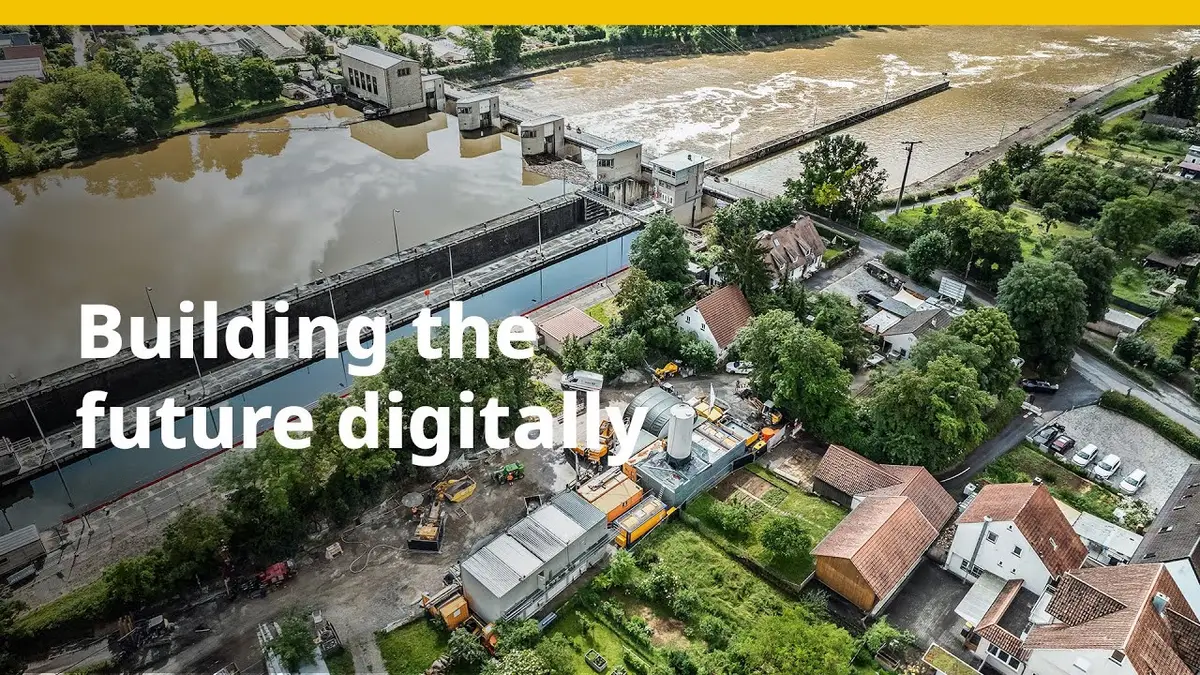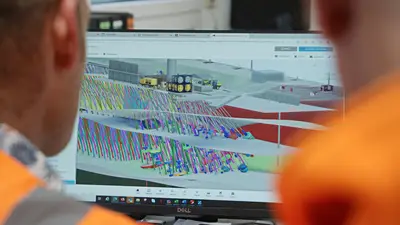Efficient and sustainable construction: Bauer Spezialtiefbau improves subsoil for the Hessigheim Lock
- State-of-the-art sonic drilling method and precise equipment used for drilling 330 boreholes
- Injection of an estimated 8,000,000 L of mortar by the end of the project
- Continuous 3D models, real-time monitoring systems and the BAUERdigital portal safeguard the design, control and adjustment process
- Close cooperation between specialists, innovative work models and successful involvement of neighboring residents
Hessigheim, Germany – Top technical performance, digital precision and outstanding teamwork all come together at the Hessigheim Lock. The subsoil here is currently being improved over an area of approx. 1,900 m². The Heidelberg Waterway Construction Authority (WNA) tasked a consortium consisting of BAUER Spezialtiefbau GmbH and BTR Bohrtechnik Roßwag GmbH & Co. KG with the required work for this project. The work started in October 2023 and is expected to be completed by February 2026. The core of the project relies on state-of-the-art methods and equipment technology to make the subsoil of the lock fit for the future. And of course, a whole lot of know-how.
330 boreholes, 8,000,000 L of mortar
The construction process is divided into five phases: First, measurement points were set up and geophysical examinations were carried out in order to document the starting station and ensure the design plans. In phase 2, the core task begins: The drilling team executes a total of 330 boreholes up to a depth of 33 m using the sonic drilling method. For this work, a special drilling rig with 3D-GNMSS measurement from BTR is used to precisely position the injection rod. Then the experts from Bauer Spezialtiefbau will execute the sealing injections using the specially configured KLEMM KR 806-2DB. A total of approx. 8,000,000 L of mortar developed in-house is expected to be inserted into disrupted soil strata, following an exact step-by-step process. This phase alone is expected to take 20 months. Phase 3 consists of more geophysical examinations and cable coring drilling works. Phase 4 involves follow-up treatment with cement injections to fill in remaining gaps.
There are major challenges to face: Unstable subsoil prevents vertical work. Drilling work must be executed obliquely from a just 3 m wide bicycle path. In addition, Operations Manager Wolfgang Benz obtained consent from residents to use their gardens for 2.5 years. The areas were prepared carefully, outfitted with concrete slabs and equipped for controlled water supply.
Thoroughly digital
Digital precision is essential for this project: Continuous digital documentation and a 3D model of the site are available to the owner at all times. A tachymetric monitoring system monitors the site around the clock and reports positional changes in real time. The Bauer experts used Building Information Modelling (BIM) technologies starting from the design phase to plan drilling and injection work down to the millimeter. “Thanks to a digital soil stratum and geotomography model, we were able to precisely analyze the soil structure,” explains Wolfgang Benz.
The centerpiece is the BAUERdigital portal, which serves as the central point of access for digital applications. Clients, assessors and construction teams can view progress here, monitor injection work and assess the measures taken. The 3D model, a digital twin, maps geometries along with injection volumes and pressures. Sensor data from the injection equipment is recorded, saved and integrated into the model, enabling precise documentation of all measures. “With these digital solutions, we make the construction process more transparent and establish a foundation for future project,” emphasizes Marcus Daubner, Head of Digitalization at Bauer Spezialtiefbau. “This project demonstrates how innovative technologies make sustainable and efficient construction possible.”
Teamwork makes it possible
Before the official start of construction, Bauer began with the exciting phase of design and preparation. The detailed 3D model of the site was created based on the owner’s baseline design. On site, the specialists control equipment precisely, inspect mortar batches in the lab and start new injection points. The biggest challenge: Inserting the injection material precisely down to the millimeter without endangering historical structures. The variety of the project is also evident from the different departments that are working hand in hand – from mortar development to equipment maintenance for efficient project implementation. Bauer Project Manager Andreas Twrznik remarks proudly: “Together we make a strong team that masters every challenge.”
Video

Press Images




Download
Your Contact
Specialized Press Geotechnical Solutions
